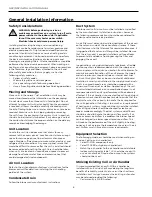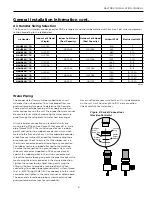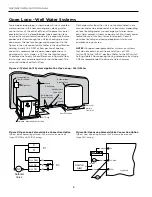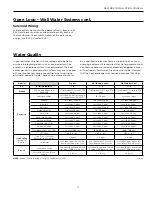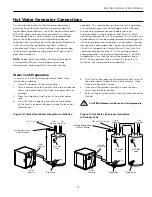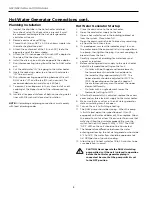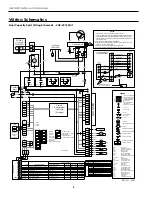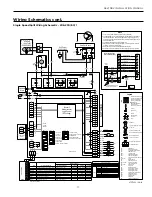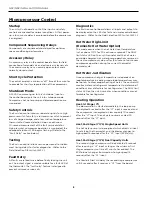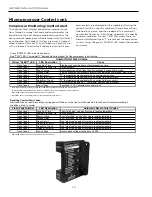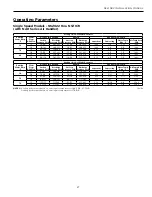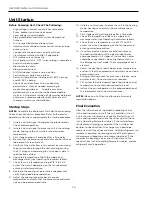
19
NSZ/NDZ INSTALLATION MANUAL
Microprocessor Control cont.
Heat, 3rd Stage (Y1,Y2,W) Single-Speed Units
The first stage of resistance heat is energized 10 seconds
after “W” input, and with continuous 3rd stage demand,
the additional stages of resistance heat engage 90 seconds
after the first stage.
Heat, 3rd Stage (Y1,Y2,W) Dual Capacity Units
The hot water pump is de-energized which directs all heat
to satisfy the thermostat. The 1st stage of resistance heat is
energized 10 seconds after “W” input, and with continuous
3rd stage demand, the additional stages of resistance heat
engage 90 seconds after the first stage.
Emergency Heat (W only)
The blower is started on high speed, and the first stage of
resistance heat is energized 10 seconds after the "W" input.
Continuing demand will engage the additional stages of
resistance heat 90 seconds after the first stage.
Cooling Operation
In all cooling operations, the reversing valve directly
tracks the “O” input. Thus, anytime the “O” input is present,
the reversing valve will be energized.
Cool, 1st Stage (Y1,O)
The blower motor and hot water pump are started
immediately, the loop pump(s) is energized 5 seconds after
the “Y1” input is received. The compressor will be energized
(on low capacity for Dual Capacity units) 10 seconds after
the “Y1” input. The ECM blower will operate at 85% of
medium speed if in dehumidification mode.
Cool, 2nd Stage (Y1, Y2, O) Single Speed Units
The blower changes to high speed (85% of high speed if
in dehumidification mode) 15 seconds after the “Y2” input
(ECM only).
Cool, 2nd Stage (Y1, Y2, O) Dual Capacity Units
The second stage compressor will be activated 5 seconds
after receiving a “Y2” input as long as the minimum first
stage compressor run time of 1 minute has expired. The
ECM blower changes to high speed 15 seconds after the
“Y2” input (85% of high speed if in dehumidification mode).
The Comfort Alert will delay the second stage compressor
until 5 seconds after it receives a “Y2” from the board.
Blower (G only)
The blower starts and operates on low speed.
Lockout Conditions
During lockout mode, the appropriate unit and thermostat
lockout LEDs will illuminate. The compressor, loop pump,
hot water pump, and accessory outputs are de-energized.
The blower will continue to run on low speed. If the
thermostat calls for heating, emergency heat operation will
occur.
Comfort Alert lockouts cannot be reset at the thermostat.
All other lockout modes can be reset at the thermostat
after turning the unit off, then on, which restores normal
operation but keeps the unit lockout LED illuminated.
Interruption of power to the unit will reset a lockout
without a waiting period and clear all lockout LEDs.
High Pressure
This lockout mode occurs when the normally closed safety
switch is opened momentarily (set at 600 PSI).
Low Pressure
This lockout mode occurs when the normally closed low
pressure switch is opened for 30 continuous seconds (set
at 40 PSI). A low pressure fault may also be indicated when
a Comfort Alert lockout has occurred.
Freeze Detection (Water Flow)
This lockout mode occurs when the freeze detection
thermistor temperature is at or below the selected point
(well 30°F or loop 15°F) for 30 continuous seconds.
IntelliStart
Some models shall be equipped with an optional
IntelliStart. IntelliStart is a single phase soft starter which
reduces the normal start current (LRA) by 60-70%. This
allows the heat pump to more easily go “off grid.” Using
IntelliStart will also provide a substantial reduction in light
flicker, reduce start-up noise, and improve the compressor’s
start behavior. The IntelliStart is self-calibrating and may
take several starts to optimize the compressor’s starting
characteristics.
Features:
Automatic adjustment of the compressor starting
•
current to the available supply voltage —maintaining
constant starting torque and current.
Supply line impedance monitoring and compensation.
•
Automatic compensation for residual backpressure in
•
the system.
Monitoring of supply voltage while compressor is
•
running to prevent motor stalling, causing excessive
currents, under low voltage conditions.
Light flicker reductions of up to 10:1 over LRA under
•
the same conditions.


